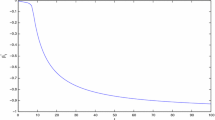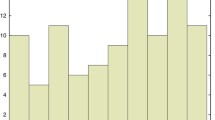Abstract
In order to solve the problem that the super-efficiency model based on directional distance function (DDF) is unable to handle negative data and infeasible under the assumption of variation in returns to scale (VRS), by choosing a suitable direction is an useful method. However, the newly chosen direction may lead to the emergence of weakly efficient projection point, which reduces the efficiency identification ability of the original model. In this paper, new direction is provided for the super-efficiency DDF model to overcome the problem of reducing the identification ability of the model. The new direction can provide strong efficient projection point for the inefficient decision making units (DMUs). The contributions of this paper are mainly as follows: (1) We find and explain the problem that the super-efficiency DDF model may have the issue of not being able to distinguish the efficiency of inefficient DMUs efficiently under some directions. (2) A new direction is provided under which the super-efficiency DDF model has a stronger ability to distinguish between the efficiency. (3) The new direction can also handle negative data while being able to ensure that the model is always feasible.



Similar content being viewed by others
References
Andersen P, Petersen NC (1993) A procedure for ranking efficient units in data envelopment analysis. Manag Sci 39(10):1261–1264
Chambers RG, Chung Y, Färe R (1996) Benefit and distance functions. J Econ Theory 70(2):407–419
Charnes A, Cooper WW, Rhodes H (1978) Measuring the efficiency of decision making units. Eur J Oper Res 2(6):429–444
Chen Y (2003a) Measuring super-efficiency in DEA in the presence of infeasibility. Eur J Oper Res 161(2):545–551
Chen Y (2003b) Ranking efficient units in DEA. Omega 32(3):213–219
Chen Y, Liang L (2011) Super-efficiency DEA in the presence of infeasibility: one model approach. Eur J Oper Res 213(1):359–360
Chen Y, Du J, Huo J (2013) Super-efficiency based on a modified directional distance function. Omega 41(3):621–625
Cheng G, Zervopoulos P, Qian Z (2013) A variant of radial measure capable of dealing with negative inputs and outputs in data envelopment analysis. Eur J Oper Res 225(1):100–105
Cook WD, Liang L, Zha Y, Zhu J (2009) A modified super-efficiency DEA model for Infeasibility. J Oper Res Soc 60:276–281
Emrouznejad A, Anouze AL, Thanassoulis E (2010) A semi-oriented radial measure for measuring the efficiency of decision making units with negative data, using DEA. Eur J Oper Res 200(1):297–304
Gan GY, Lee HS (2021) Resolving the infeasibility of the super-efficiency DEA based on DDF. Ann Oper Res 307(1–2):139–152
Hatami-Marbini A, Pourmahmoud J, Babazadeh E (2018) A modified super-efficiency in the range directional model. Comput Ind Eng 120:442–449
Hv A, Esmaeilzadeh A (2013) A new super-efficiency model in the presence of negative data. J Oper Res Soc 64(3):396–401
Lee HS, Chu CW, Zhu J (2011) Super-efficiency DEA in the presence of infeasibility. Eur J Oper Res 212(1):141–147
Lin R, Chen Z (2015) Super-efficiency measurement under variable return to scale: an approach based on a new directional distance function. J Oper Res Soc 66(9):1506–1510
Lin R, Chen Z (2017) A directional distance based super-efficiency DEA model handling negative data. J Oper Res Soc 68(11):1312–1322
Lin R, Chen Z (2018) Modified super-efficiency DEA models for solving infeasibility under non-negative data set. INFOR Inf Syst Op Res 56(3):265–285
Lin R, Liu Y (2019) Super-efficiency based on the directional distance function in the presence of negative data. Omega 85:26–34
Portela MCAS, Thanassoulis E, Simpson G (2004) Negative data in DEA: a directional distance approach applied to bank branches. J Oper Res Soc 55(10):1111–1121
Ray SC (2005) The directional distance function and measurement of super-efficiency: an application to airlines data. J Oper Res Soc 59(6):788–797
Tang J, Liu J, Chen J, Wei F (2020) Performance ranking method based on superefficiency with directional distance function in DEA. Math Probl Eng 2020:1–7
Vaez-Ghasemi M, Moghaddas Z, Saen RF (2021) Cost efficiency evaluation in sustainable supply chains with marginal surcharge values for harmful environmental factors: a case study in a food industry. Oper Res Int J 22(5):5897–5912
Wu J, Zhu Q, Yin P, Song M (2015) Measuring energy and environmental performance for regions in China by using DEA-based Malmquist indices. Oper Res Int J 17(3):715–735
Funding
This research is supported by National Natural Science Funds of China (Nos. 72171124, 72171122), Project of Jiangsu Qing Lan Excellent Teaching Team and Jiangsu Social Science Excellent Young Scholars. This research was also supported by The Postgraduate Research & Practice Innovation Program of Jiangsu Province (KYCX23_0932).
Author information
Authors and Affiliations
Corresponding author
Ethics declarations
Conflict of interest
The authors declare that they have no conflict of interest.
Additional information
Publisher's Note
Springer Nature remains neutral with regard to jurisdictional claims in published maps and institutional affiliations.
Rights and permissions
Springer Nature or its licensor (e.g. a society or other partner) holds exclusive rights to this article under a publishing agreement with the author(s) or other rightsholder(s); author self-archiving of the accepted manuscript version of this article is solely governed by the terms of such publishing agreement and applicable law.
About this article
Cite this article
Zhu, W., Bai, Z. & Yu, Y. A super-efficiency model based on the directional distance function under a new direction. Oper Res Int J 25, 20 (2025). https://doi.org/10.1007/s12351-025-00901-9
Received:
Revised:
Accepted:
Published:
DOI: https://doi.org/10.1007/s12351-025-00901-9




